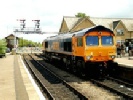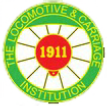Archive Section




By Nick Agnew, President The Locomotive & Carriage Institution.
The March seminar saw members of the Institution, together with colleagues from the Newcomen Society, assemble at the Fairfield Hotel for three presentations that between them covered not only the history of the tram in Croydon, but that of the flanged wheel vehicle. John Gent, the first speaker gave an illustrated presentation showing rail transport from the days of the Surrey Iron Railway that ran between Wandsworth and Croydon from its opening in 1803 until closure in 1896. To ensure the theme of the day was maintained, John explained that as part of that railway had been used for 'Tramlink' services, the latter could arguably be described as based on the oldest public railway in the world.
John went on to focus on the development of the tram from early horse drawn vehicles, through experimental battery powered vehicles to the arrival of electrification in 1901. For some years, the municipal operation kept the approaching 'South Met' at bay, and was known for providing LT with an 'inheritance' of open topped cars, the last of which ran on the Crystal Palace route until 1936. Isolation ended with the installation of six miles of track at Norbury to link the municipal routes with those of the 'South Met' and a direct result was the purchase by the Corporation of larger cars for routes beyond the old boundary. Another consequence was the abandonment of the Addiscombe route in March 1927, to improve the financial position -
Although final abandonment was deferred by the war and subsequent post war shortages, Croydon said goodbye to the tram on 17th April 1951 -
Jim described the background to the project, which led to tenders being sought in November 1996. A contract to design and build the system had subsequently been let to Amay/McAlpine, a Construction Joint Venture group. Funding was split between the Treasury (50%) and a combination of the banks, the operator, vehicle builders and the construction consortium. Operations were the responsibility of Tram Operations Ltd, with maintenance being included in the 30 year contract. Jim joined the project in March 1997 and the first construction works commenced later that year. Although some sections utilised former 'heavy rail' alignments, the project had involved "newbuild" that had seen considerable relocation of existing utilities, accounting for 10% of the overall project cost! Various problems had been overcome ranging from sleeper overlaying manhole covers to the much publicised debate over traction poles! Credit was given to the civil engineers for ensuring that the various work packages had delivered the network without major problem. The opportunity had been taken to learn lessons from earlier systems in Sheffield and Manchester and the Borough of Croydon had also used that experience to "zone" construction areas.
Care had been taken with track laying, to reduce vibration and rails were glued to a polymer rubber 'mat'. Minimal vibration was particularly important where tracks ran in close proximity to buildings, such as the old Aimshouses in Central Croydon. Installing overhead line masts had proved very expensive, with many Poles requiring the footway to be disturbed. Base design varied considerably and the one metre square blocks had been adopted at many locations to accommodate adjacent services.
Turning to the vehicles themselves, Jim said that an early decision had been to choose a proven design, which had since been justified by the excellent performance since commissioning. The twenty-
The programme for the day included a visit to the control centre located at the depot and Jim explained that signalling was employed on the system reflecting the combination of single-
Since operations commenced, traffic had increased with passenger levels in the first year already exceeding those of 'Metrolink' in Manchester, a similar sized system. Feedback from users showed that the system was popular, particularly amongst those "handicapped" in the wider sense. The numbers of baby buggies carried supported this, whilst the trams had allowed access to Central Croydon form some who had found such journeys denied them for many years. Jim concluded by responding to a number of questions before handing over to John Rymer, Managing Director for Tram Operations Ltd, the 'First' group subsidiary responsible for operation of the services.
John commenced his preparation by confirming the favourable response to the system by both staff and passengers. Staff have a different perspective on equipment provided and were keen to influence key aspects of design, in order to a be proud of the 'end product'. This had been true in Croydon as with other systems, whilst feedback from customers showed an encouraging level of commendation, even if some were included in complaints!
Turning to the network, the tramway was designed as an orbital link and provided connections with 53 bus routes as well as 'heavy rail' at various locations. Reliability comparisons with bus services were encouraging and commercial speeds of 25 kph compared favourably with other European systems. Priority signalling assisted reliable operation. Pedestrian areas coupled with environmental improvements carried out by Croydon Council. Preservation and continuity of city centre operations in the face of out of town retail developments had been a factor and he confirmed Jim's comment that accessibility had been greatly improved to and from the areas served. One passenger had not been to Croydon for five years prior to the system opening!
There was evidence that some accompanied by buggies were now taking the tram in preference to the car, whilst some had even travelled with supermarket trolleys -
Turning to the existing operation, John commented on the ability of such a system to attract new users. Presenting new and old users with a friendly, clean environment was clearly a requirement, together with a regular service and 'highly viable' infrastructure that gave a feeling of permanence and confidence, vital factors if growth was to be achieved. Service delivery would still be reliant on people however and in looking to the future, the interface between control staff, drivers and engineering staff would be a critical factor in being able to build on the early positive reactions to the arrival of the tram.
The morning session concluded with questions to the three presenters and a vote of thanks on behalf of the Institution from Nick Agnew. A buffet lunch followed after which those present split into smaller groups for a visit to the network and the Control Centre and Depot at Therepia Lane. It was at this point that the cause of earlier "blues and twos" became apparent, with trams from the east terminating at East Croydon. A hapless motorist had appeared in front of a tram whilst carrying out a sudden 'U-
Finally thanks to all those who provided hospitality for our visit to Croydon and to those members of both organisation who supported the seminar.